Hullo and velcome to my blog! (I hope you read that in a Russian accent)
Today’s post is my entry into Lina’s recipe challenge for February, which was cakes from around the world. What a fun idea! I picked Ruske Kape, or Russian Hats, which are adorable little individual cakes, which kind of resemble (surprise surprise) Russian fur hats. According to Wikipedia, they are from Bosnia, Croatia and Serbia. They consist of two layers of spongey chocolate cake, sandwiched together with buttercream, decorated on the sides with coconut and topped with chocolate. Yum!
Now, I have to admit, this WAS indeed a challenge. In fact, it kind of reminded me of the sensation of being in a foreign country, when you don’t speak the language, don’t know the culture, and don’t have a clue what’s going on! I followed the instructions carefully (which were somewhat confusing), but haven’t felt so much uncertainty whilst baking for a long time! Anyway, I decided that the unease I felt was an appropriate part of the experience of making a foreign recipe!
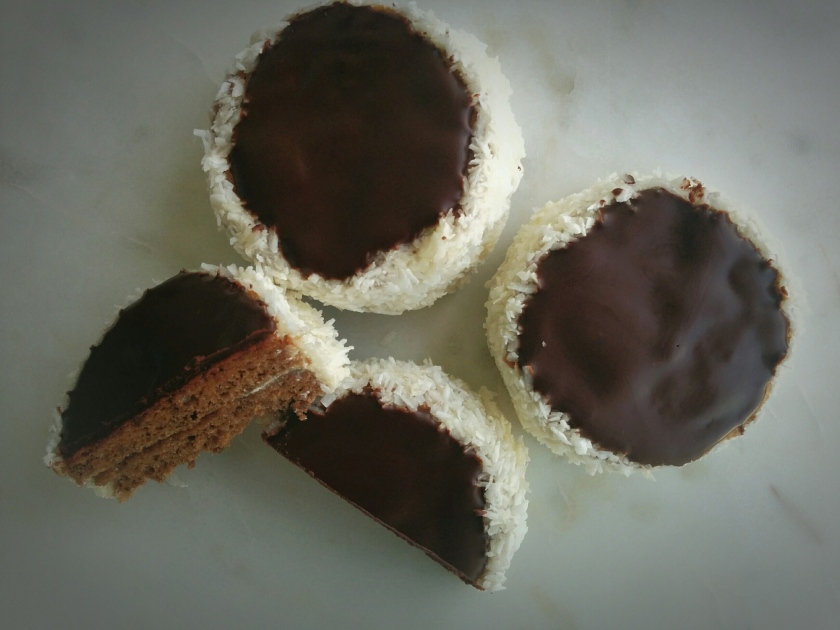
Step one: Finding a recipe
This wasn’t too hard, however there weren’t a lot of different recipes out there for me to compare (at least, not in english!). I found one here, which has also been blogged about here. The recipe had weird units of measurements… mostly metric, but then some large quantities measured out in tablespoons… why bother? 10 tablespoons just doesn’t seem like a sensible way to measure water!

Step two: Making the cakes
This step was fairly straightforward (though it did require three bowls! Not ideal.), however I don’t think I’ve ever baked anything with a full dozen eggs before. I actually bake a fair number of eggless recipes, so I found the aroma of egg in my kitchen a little overpowering.
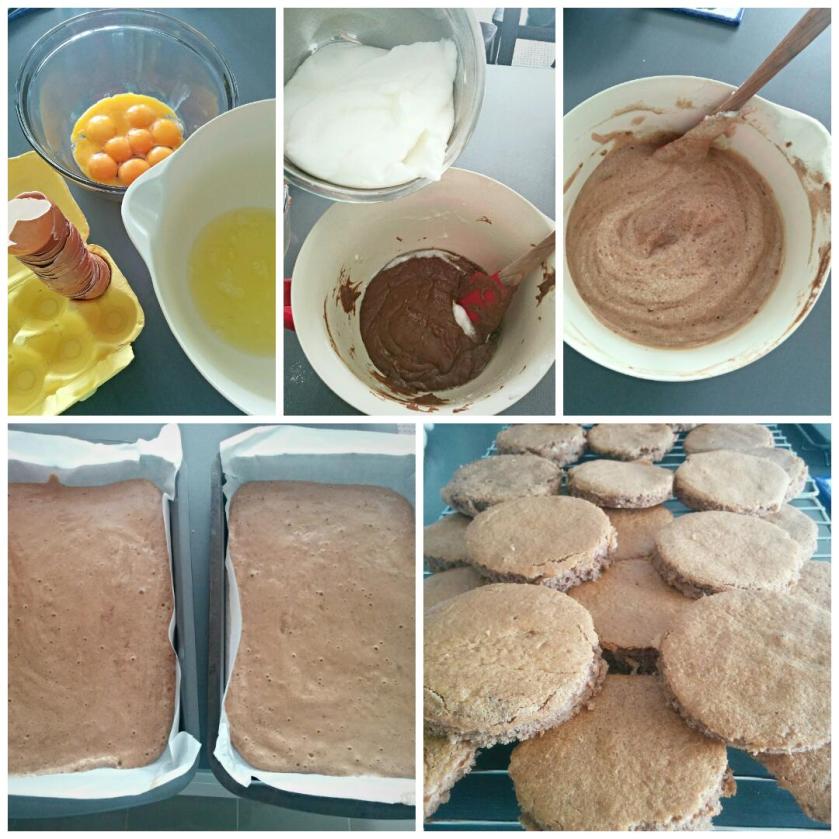
I also had to purchase a second baking tray in order to bake both layers at the same time (they’re cheap and stack well, so I didn’t really mind). There didn’t really seem to be enough mixture to cover the whole tray, but I warily spread it out anyway. That worked okay, as the batter did rise a little bit.
I was surprised how soft the cooked cake turned out. I don’t know why, but I’d kind of imagined it being crunchy, possibly because I only really use that many eggs when making pavlova or meringues. Also, the pictures I’d seen online kind of reminded me of the alfajores I’d had in Argentina, which are like biscuits.
I used a jar lid to cut them into circles and had heaps of scraps leftover. They don’t taste like much on their own, to be honest.
Step three: Making the buttercream
“Am I making buttercream or cheese sauce?” Was a thought that genuinely ran through my head while making the buttercream. I’ve never made buttercream by thickening milk, flour and sugar before.
Really, this step was my undoing. While the milk mixture cooled it formed a skin which was kind of gross. I mixed it in. Then, I combined the cooled thickened milk with the creamed butter and sugar, but it didn’t really thicken enough to my satisfaction. So I kept beating, and then decided to refrigerate it, in the hope it’d thicken up some more. Unfortunately the mixture curdled and looked sloppy and unappetising. It also had that vague floury aroma that white sauces have, which I thought was most unusual for a buttercream. I skeptically ploughed ahead.
Step four: Making the glaze
This step was a piece of cake (tehe, see what I did there?). Easy peasy lemon squeezy. Combine chocolate, butter and oil in a double boiler and then allow to cool. Finally, something I’m familiar with!
Step five: Assembly
Next was the messy and fun part. Sandwich together two cake rounds with a layer of sloppy, curdled “buttercream.” Then coat the outsides with buttercream and roll in desiccated coconut. I’m sure I used more than the 150g called for in the recipe, but I had plenty on hand. The coconut layer hid the yucky looking buttercream sludge and actually made it look quite nice. Then, I spread over the glossy chocolate glaze, right up to the edges of the coconut. This really was the icing on the cake (tehe), and gave the whole ensemble a polished, professional look.
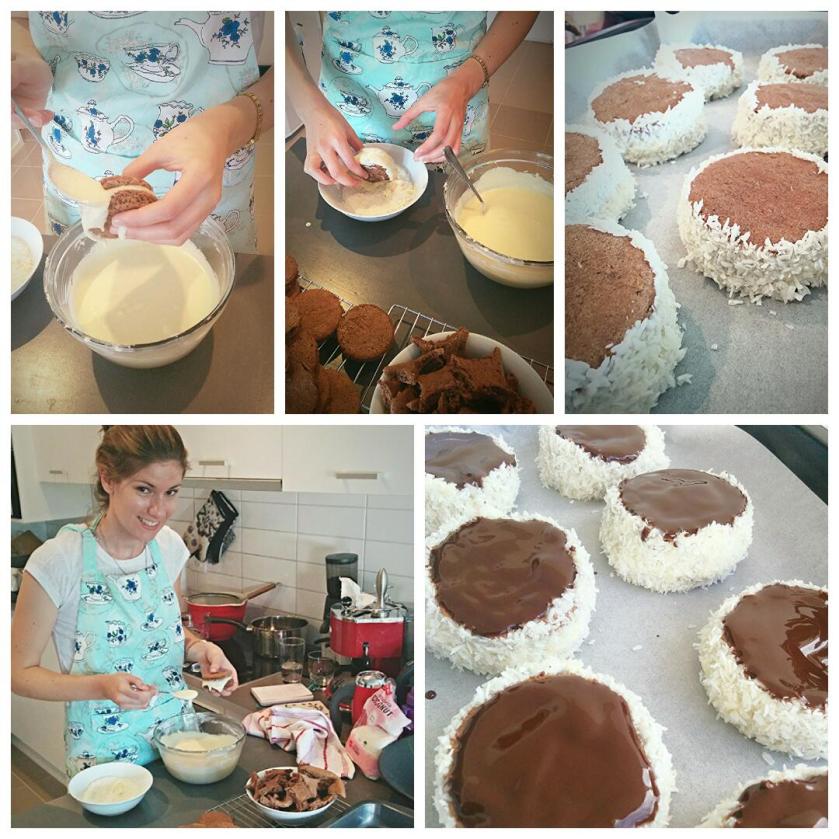
It was a very warm day (27ºC!) so I put them in the fridge to set (regrettably discovering that my baking trays don’t quite fit into the fridge, meaning I had to transfer all the delicately assembled cakes into another container…. doh!).
The Verdict
They actually tasted pretty darned good! The recipe made 15 cakes, so I gave a few to some friends, who also quite liked them. They were definitely a fiddly operation, but they turned out pretty tasty and visually appealing. If I were to make them again, the main thing I’d do differently would be to make a normal buttercream icing. This would be thicker, so there would be more icing between the cake layers (you can’t even really tell there is icing between them!) and wouldn’t cause so much distress! Honestly, the heart break of having curdled buttercream was intense.
Enjoy! xo (Also, shout out to judges Suzanne and Jhuls!)
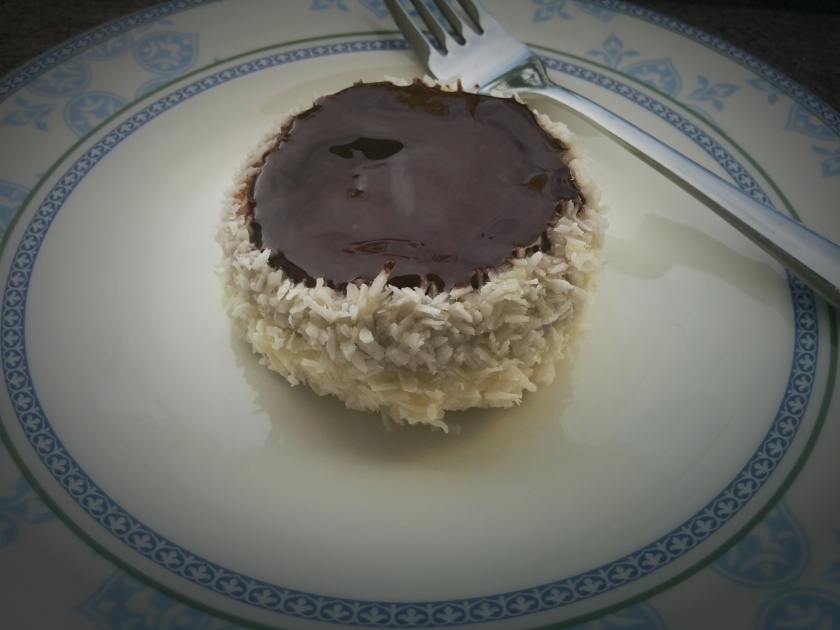
Ruske Kape (Russian Hats)
Ingredients
For the cakes:
- 3 tablespoons cocoa powder
- 1 3/4 teaspoons baking powder
- 250g flour
- 12 eggs, seperated
- 165g caster sugar
- 2/3 cup (160ml) water
For the buttercream:
- 500ml milk
- 5 tablespoons flour
- 1 teaspoon vanilla essence
- 150g caster sugar
- 125g butter
- 100g icing sugar
For the glaze:
- 100g dark chocolate, in pieces
- 50g butter
- 2 tablespoons canola oil
- At least 150g desiccated coconut
Instructions
For the cake:
- Preheat the oven to 180ºC, conventional bake.
- Line 2x large oven trays with baking paper. Mine were 27cm x 40cm.
- In a medium bowl, sift together flour, baking powder and cocoa. Combine.
- In a large bowl, beat egg whites until the soft peak stage. Continue beating and gradually add 65g sugar.
- In another large bowl, beat together egg yolks and 100g sugar. Add water and and dry ingredients and mix until smooth. Fold in egg whites and combine. Try not to mix too roughly or you’ll lose the volume of the whites.
- Divide the batter evenly between the two trays and spread it out.
- Bake for 20 minutes, or until a skewer comes out clean.
- Allow to cool, and then cut into rounds using a circular cookie cutter or a cup.
For the buttercream:
- Combine milk, flour, caster sugar and vanilla in a medium saucepan.
- Heat over a medium heat until thick. Whisk continuously to avoid lumps.
- Remove from heat and allow to cool. Stir occasionally to avoid the formation of a skin.
- In a medium bowl, cream butter and icing sugar until pale.
- Add butter mix to cooled milk and beat until smooth.
For the glaze:
- Combine chocolate pieces, butter and oil in a double-boiler.
- Heat, stirring constantly, until melted and smooth.
- Remove from the heat and allow to cool.
To assemble:
- Take one cake round and cover the surface with buttercream. Sandwich on top another round. Coat the sides with buttercream and roll in dessicated coconut. Repeat until all cake rounds have been used.
- Place a spoonful of chocolate glaze onto the top of each cake and use a spoon to spread out to the edges of the coconut.
- Refrigerate until set. Serve chilled.
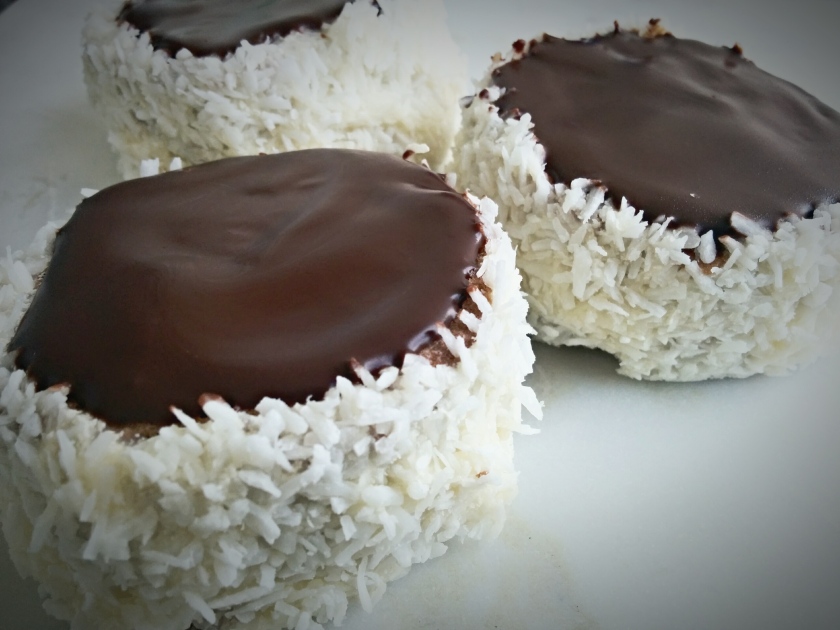






so very well explained 🙂 lovely looking beauties
LikeLike
Thanks!!! 😀
LikeLiked by 1 person
They look delicious! I love them 🙂
LikeLiked by 1 person
Thank you! They were pretty tasty! 🙂
LikeLike
I know the pain of the curdled cooked-flour buttercream. The trick is to make sure that the butter and the roux (which should be extremely thick, not runny at all) are both at room temperature when you beat them together. If one is colder than the other it’s much more likely to curdle.
LikeLiked by 1 person
Ahh! Thanks for the tip!
LikeLike
Was this like an Ermine frosting?
LikeLike
Omg! This looks like a hard one! But you have mastered it so well! Wonderful! Beautiful pics! Good job I have to say!!!!! I totally loved to have you as a part of this challenge☺☺☺ Looking forward to see you participating in the coming challenges too:) btw just add a link of the judges posts so that they get notified ☺
LikeLiked by 1 person
Thanks Lina, I really enjoyed participating! 🙂
LikeLiked by 1 person
😊
LikeLike
Your cakes look beautiful! And they sound really tasty too. I’m intrigued by the buttercream and it was very interesting reading about the process. The sponge looks so nice and moist too! Yay for Russian hats! 🙂
LikeLiked by 1 person
Thanks Lili! 🙂
LikeLiked by 1 person
Hello, Rebecca! It is so much lovely to meet you at the challenge which not only provides unique recipes to try, but also brings bloggers together. 🙂
These ‘Russian Hats’ are so beautiful. They indeed look like hats. 😀 I love reading the things you have gone through while making these beauties. And those eggs – wow! I’ve never baked using a dozen, too.
Bravo for doing a brilliant job! They look so pretty and delicious! Thank you for participating! 🙂
LikeLiked by 3 people
Thanks Jhuls! I’m glad you enjoyed my post, I had a lot of fun putting it all together 😀
LikeLike
They look great. You did a wonderful job. I know boiled icing can be tricky. Your little cakes look just beautiful.
LikeLiked by 1 person
Thanks!!! 😀 😀
LikeLike
Wow these look fiddly but doesn’t the final effect look fabulous! Perfect accompaniments for a party or special afternoon tea. I am impressed but also think I would stick with the standard buttercream
LikeLiked by 1 person
Thank you! Yes, they were rather fiddly! It was good to have a relaxed Saturday to spend making them, I wouldn’t want to be rushed making them!
LikeLiked by 1 person
It sounds like a relaxed Saturday would mean you have time to enjoy eating one or two as well.
LikeLiked by 1 person
Your cake looks so adorable! Such a detailed and well explained post ! You did an amazing job executing these 🙂
LikeLiked by 1 person
Aww, thanks Freda! 😀
LikeLiked by 1 person
These turned out incredibly! Plus an enjoyable post to read. Reading about the buttercream and your skepticism/determination to move forwards made me laugh (I’ve been there with uh…too many things). So glad you persevered and ended up with such pretty and delicious cakes!
LikeLiked by 1 person
Hehe, thanks! Yes, it was definitely an interesting experiment! Worth it in the end though. 🙂
LikeLiked by 1 person
My first time here and those Russian hat cakes look pretty amazing 🙂 Loved how you described the recipe as if it were a chemistry lab experiment 😀 Glad I found your blog through Lina’s challenge!
LikeLike
Welcome! Glad you liked it! Maybe I subconsciously detailed it like a science experiment because I’m a scientist! Haha! 🙂
LikeLiked by 1 person
Now that’s interesting to know 🙂
LikeLike
Amazing… Loved your write up. I had the same issue for the last month challenge. The recipes were in urdu. lol.. Love the coconut in baking.. the aroma and the flavor is superb.
LikeLiked by 1 person
Thanks Srividhya! Yes, following a translated recipe does make things a bit trickier!
LikeLike
Fist time here and I loved reading your post. Ruske kape looks absolutely stunning and delicious!
LikeLiked by 1 person
Thank you!!! 🙂
LikeLiked by 1 person
Hi! Being from Serbia, I have a piece of advice:
When cooking the filling, use cornstarch, not flour. Ratio is (circa) 100 grams of cornstarch for 1 liter of milk. Of course, you can half the amounts or double them, depending on how much filling you need. Basically, you make it very similarly to custard cream, just in this case without the eggs. Although you can add some eggs, in which case you’ll get classic, yellow custard cream, and without eggs it will be white. Add sugar and vanilla, of course…
Filling Ruske kape with buttercream would not be… IT.
And feel free to make them smaller, 3-4 cm. They should be dainty enough to be “finger food” 🙂
LikeLike
Great tips! Thanks for commenting!
LikeLike
You’re welcome 🙂
And also, I forgot to add – 12 eggs is exactly three times more than really needed for 250 grams of flour. 4 eggs is enough. 100 ml of water, 100 ml of oil. Cocoa – circa 2 table spoons (but you can add more or less, to taste). 1 tsp of baking powder. And there you go.
I’m sorry if this sound condescending – it’s not, really. It’s just that I can see how much effort you put in this, and somehow you got, well, not so good recipe. And American and European ways of making cakes, cookies and such are just very different. There’s almost always a need to substitute this for that; for example, you won’t find maple syrup here in Serbia, and packages of chocolate chips are not “family size” but “bakery size”…
Thank you for your time. All the best 🙂
LikeLike